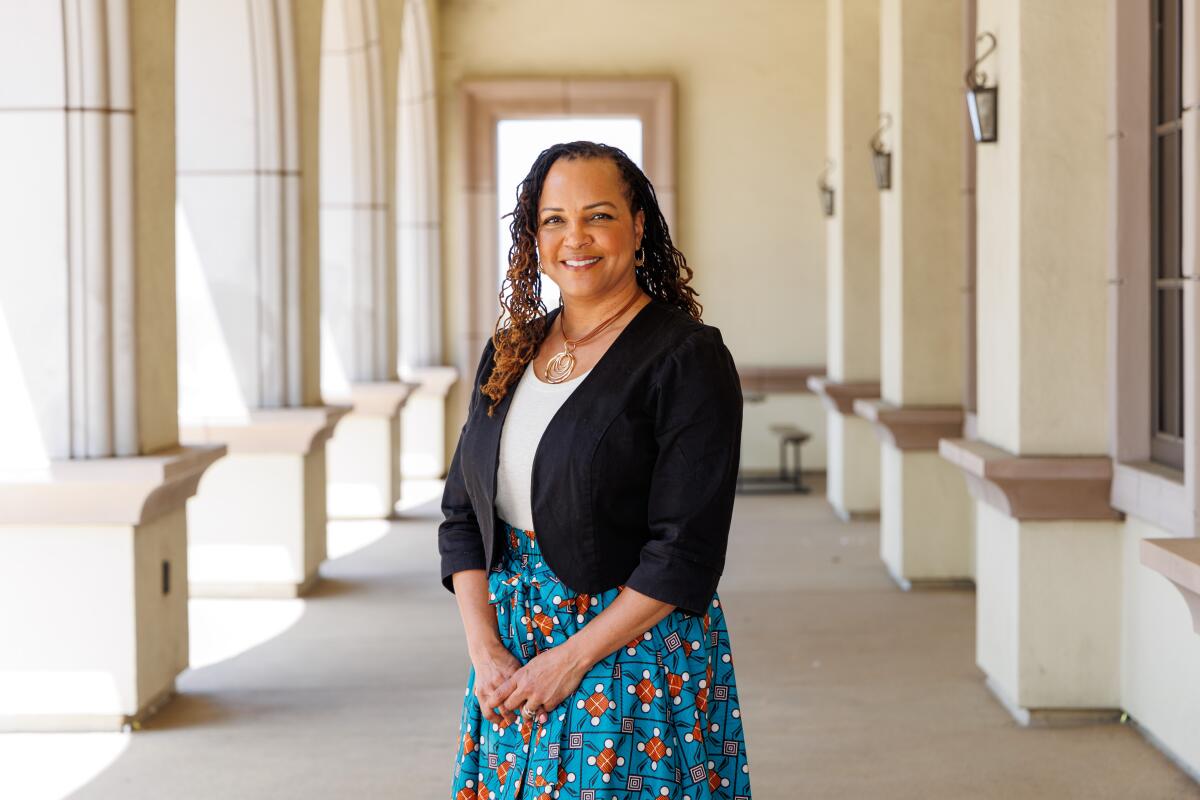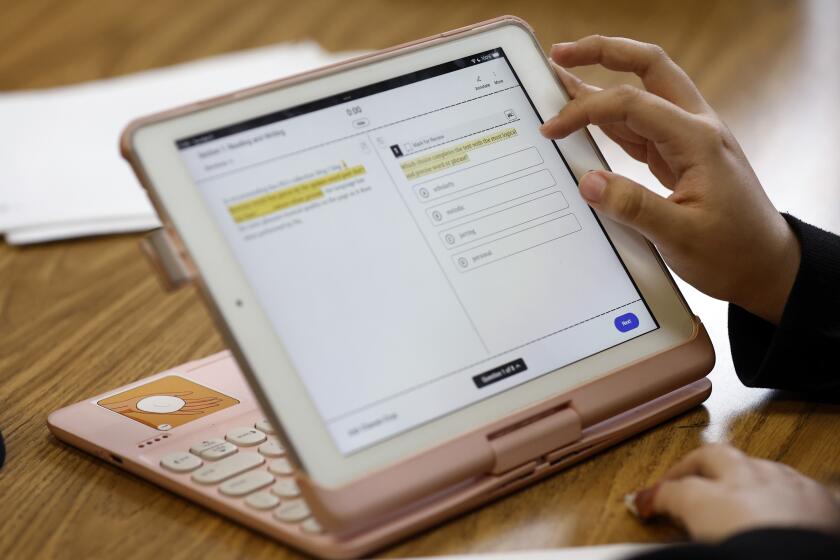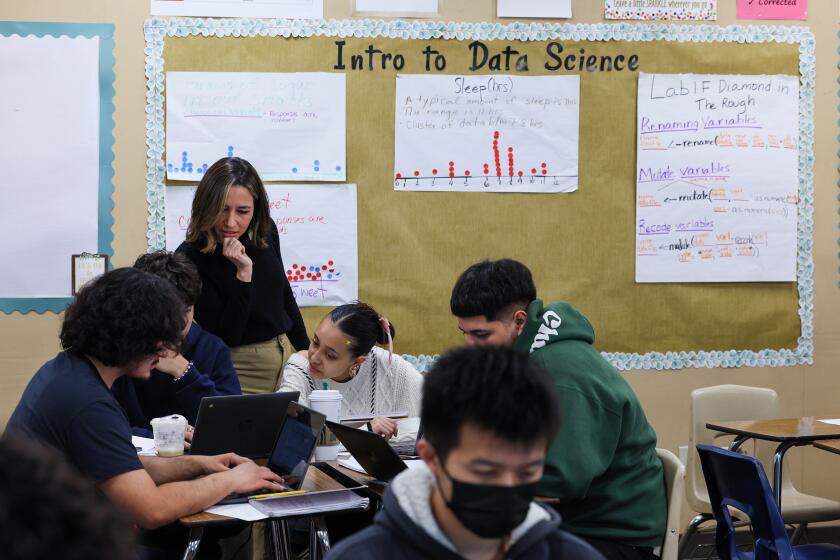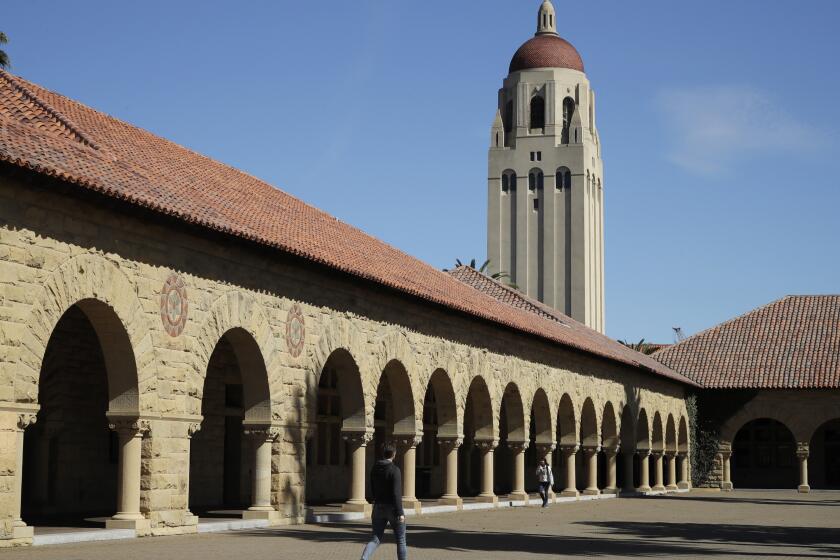Autism, dyslexia, ADHD. How the University of San Diego is helping ‘neurodivergent’ students succeed

- Share via
Niki Elliott skipped the fifth grade. She was so smart that she could have skipped another, she said, but her mother didn’t want her in class with older boys.
She was bored in school. She had a “near photographic” memory and didn’t need to study — so she never learned how to, Elliot said. She remembers finishing her assignments in five minutes and spending the next 30 waiting for her classmates to catch up.
But when she got to college, classes were difficult. “I really had a big crash and burn,” she said.
Experts call students like Elliott “twice exceptional,” a term used to refer to children who are gifted in some areas, but also experience a learning or developmental challenge. In Elliott’s case, that challenge was attention deficit/hyperactivity disorder, which made it difficult for her to manage her time and attention.
She remembers being in college and thinking, “People told me I was so smart, but why am I struggling so hard?”
Elliot went on to become a special education teacher, and said she never stops thinking about how to create a world in which a young Black student like herself could be taught to work with — instead of against — her learning differences. Now a professor in the School of Leadership and Education Sciences at the University of San Diego, she’s helping to open the school’s Center for Embodied Equity and Neurodiversity in August.
At its simplest, neurodiversity is the idea that everybody’s brains work differently, and that these differences are normal. Neurodivergent, which is not a medical diagnosis, is an umbrella term that refers to people who have autism spectrum disorder, ADHD, dyslexia, or other atypical ways of thinking, learning and interacting with others.
“Embodied equity,” the other term in the new center’s name, refers to an anti-discrimination approach that considers all aspects of people’s identities — including race, gender, ability, socioeconomic status — when addressing social problems.
Most Asian Americans think it’s fair to consider SAT scores — but not race or ethnicity — in college admission, according to a study that comes as several universities have restored standardized testing requirements for first-year applicants.
Elliott said the center’s work will fall into four main categories: training K-12 teachers and support staffers, training community college educators, working on policy issues that affect neurodivergent students and offering programs to set up such students for success in college and the workplace.
The training is being funded through contracts with schools, colleges and other organizations; additional costs will be covered by grants from philanthropic foundations, Elliott said.
“We really have to work to change the mindset of faculty to understand the ways in which these adaptations to their delivery and development of content could make all the difference for so many more highly bright and capable students to thrive in higher ed,” Elliott said.
If teachers and education support staff are equipped with strategies to help students whose brains work differently, Elliott hopes that more of these students will have the option to go to college.
As the public understanding of brain differences expands, college leaders are trying to help make campuses become more hospitable to neurodivergent students.
A task force at UC Berkeley, for example, is focused on medical care and access to screenings or assessments; potential and curriculum changes and disability accommodations for students and for employees, who are often graduation students.
The needs of neurodivergent students force academics to confront a bias in which needless inflexibility is equated with academic rigor, said Lisa García Bedolla, vice provost for graduate studies, who is leading the effort.
San Diego State University offers a class focused on cognitive and social differences. It’s designed for neurodivergent students or those who want to work in fields such as social work, special education or psychology. According to the course description, topics include executive functioning and time management; social cognition, context awareness and how to take on the perspective of another person; and communication and relationship skills and self-advocacy.
The university systems reversed their approval of three high school data science classes to substitute for algebra 2, stirring up a furious debate.
Inna Fishman, the founding director of SDSU’s Center for Autism and Developmental Disorders, said that although there’s been a “huge paradigm shift,” meaningful change for neurodivergent college students will take time.
This work is also complicated because definitions of neurodivergence vary and it’s difficult to know how many students stand to benefit.
Many experts believe the number of students with brain differences that fit under the neurodivergent umbrella is growing, whether because of an increase in people with such conditions or because of reduced stigma, greater awareness and better identification of such conditions.
The number of colleges where at least 5% of students report having a disability has risen from 510 in 2008 to 1,276 in 2022, according to data from the Integrated Postsecondary Education Data System. But this measure is imperfect: It includes students who have physical disabilities. Also, roughly two-thirds of college students with disabilities choose not to disclose it to their college.
“A lot of students when they leave K-12, they want to wash their label off of them and start fresh,” Elliott said. “They want to believe that they can do well in college without it, or that they would be mistreated or stigmatized if they let people know.”
Experts say that students whose brains work differently often face challenges during their K-12 education; when they get to college, the challenges don’t stop, they just change.
Laudan B. Jahromi, a professor of psychology and education at Teachers College at Columbia University, said these students often struggle with what she called “cognitive flexibility,” which can affect time management, planning, prioritizing and other such organizational skills, and make college classes more difficult to manage.
Fishman, at SDSU, said students with brain differences might need help taking notes, more time to take exams or to have instructions repeated to them multiple times. They might miss certain nonverbal communication or cues from their professors or peers.
Colleges offer accommodations that can help with some of these challenges, but often students can only unlock this help with a qualifying diagnosis, which can be difficult to get, depending on a student’s health insurance and access to the appropriate assessments.
Many neurodivergent students use medications that must be taken on a certain schedule to help manage their conditions, Elliott said. Problems arise when students’ classes are only offered at a time that doesn’t work with their medication schedule. If the students need a course to progress in their major, then they’re stuck trying to pass in conditions that don’t make sense for them. Elliott said this can lead attrition or underperformance.
And physically being in the classroom can cause stress for students who are sensitive to factors such as flickering fluorescent lights or certain types of sounds, or who have difficulty being around large groups.
A new California legislative effort to ban state financial aid to colleges and universities that give admissions preferences to children of alumni and donors could hit USC, Stanford.
Some neurodivergent people struggle with understanding social dynamics and cues, or with social anxiety. Sometimes requiring social interactions involving graded group projects, puts them at a disadvantage. Socialization can pose significant challenges for these students outside the classroom, too, as they navigate community living, friendships and dating.
The students must also be their own advocates, often without fully understanding their own needs.
Elliott said the new center will offer a program that will support Black students with and without brain differences starting in sixth grade. The idea is to help students understand their learning styles, what they need to be successful in school and how to advocate for themselves as they move toward college. If the students finish high school and qualify for admission to the University of San Diego, they will have a they will have a full scholarship to attend.
Next year, Elliott said, the center will begin offering a summer bridge program specifically for neurodivergent students, with a similar curriculum.
“It’s teaching each person where their gifts are, how they contribute to a whole and how to use that to navigate a successful higher ed experience,” Elliott said.
This story was produced by The Hechinger Report, a nonprofit, independent news organization focused on inequality and innovation in education.
More to Read
Sign up for Essential California
The most important California stories and recommendations in your inbox every morning.
You may occasionally receive promotional content from the Los Angeles Times.













